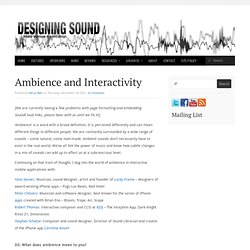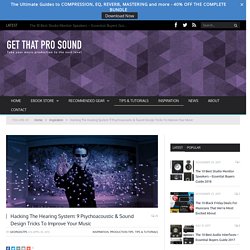

Nate Harrison. Audio, Distortion and Feedback. Audio. Audio 101. Cable Anatomy PT1: Microphone. What is impedance?

Impedance is the AC (alternating current) version of the DC (direct current) term resistance, which is the opposition to electron current flow in a circuit and is expressed in ohms. Cable Anatomy PT2: Loudspeaker Cable. Cable Anatomy PT3: Instrument. See Part 1, Microphone Cable here and Part 2, Loudspeaker Cable here.

Are instrument cables used for high-impedance or low-impedance lines? Generally, the source impedance is the determining factor in cable selection. Instrument cables are used for a wide range of sources. Many keyboard instruments, mixers, and signal processors have very low (50 to 600 ohm) source impedances. On the other hand, typical electric guitar or bass pickups are very inductive, very high impedance (20,000 ohms and above) sources. Psychoacoustics. Ambience and Interactivity. [We are currently having a few problems with page formatting and embedding SoundCloud links, please bear with us until we fix it!]

‘Ambience’ is a word with a broad definition. It is perceived differently and can mean different things to different people. We are constantly surrounded by a wide range of sounds – some natural, some man-made. Music To Your Ears. How The Ear Works. The most important pieces of hardware in any studio are the ones on the sides of your head.

We look at the amazing journey your music makes on its way to the brain... How We Hear Pitch. When two sounds happen very close together, we hear them as one.

This surprising phenomenon is the basis of musical pitch — and there are lots of ways to exploit it in sound design. Emmanuel Deruty Films and television programmes consist of a series of individual still images, but we don't see them as such. Instead, we experience a continuous flow of visual information: a moving picture. 9 Psychoacoustic Tricks.
When talking about improving the perceived quality of our productions and mixes, its easy to focus mainly on the technology we use, or the layout and acoustic treatment of our listening environment.

Psychoacoustics: Faking the Space. When building the space that sounds occupy, it may sometimes seem like overkill to load up those DSP hungry (though wonderful) reverb plug-ins. They can be a pretty big load when it comes to even the mildest amount of spatialization, and it can also be time consuming to configure one to emulate an outdoor space. I thought it would be worth sharing a trick of mine for both situations. Acoustics and Psychoacoustics. Purple Sounds Best. Purple loudspeakers sound better than black ones.

At least that’s what I hear when I see them. And plaid loudspeakers sound, well, more complex, with additional harmonics. Digital. Dither vs Distortion. The video above demonstrates what quantisation distortion sounds like, and how dither solves the problem.

And along the way, why you should always use dither when saving 16 or 24-bit files. Analyzing Loudspeakers & DSP. As sound reproduction has transitioned to the digital realm, audio professionals have a wealth of capabilities that were unthinkable in the analog days.

Today, loudspeakers with companion digital processors are increasingly a tool of choice, going well beyond just the higher end of the application spectrum. Virtually all types and brands of digital loudspeaker processors offer a rich suite of features, often overwhelmingly so. Some have capabilities that are unique, while others seek to capture the most important functions at the lowest possible price point. Nearly all provide a comprehensive set of functions that, if compared in a vacuum to the analog crossovers of yesteryear, would actually seem to be science fiction rather than reality.
Harnessing The Power Of DSP. In the previous segment, we looked at the basic process of using a high-resolution FFT (Fast Fourier Transform) analyzer to view the frequency and phase response of a 12-inch cone driver in a typical 12-inch/2-way loudspeaker.

In that segment, we established that the 30-degree off-axis response of the cone driver is substantially lower in level (12 to 18 dB), as well as highly irregular in phase and frequency above approximately 2 kHz, when compared to the driver’s on-axis response (Figure 1). This information allows us make an educated guess at the range where the cone driver should be crossed over. In this particular case, the 30-degree off-axis response is linear up until about 1.28 kHz, after which the output until about 2 kHz.
Invention. History of Sound Recording Technology. Magnetic Tape History. Invention Of The Phonograph. Five milestones in music technology. Last week an audio clip emerged that is apparently the oldest recording of the human voice in existence. It's a ten-second clip of a woman singing a French folk song, and was recorded in 1860 on a device called a phonautograph. You can hear it here. The last two hundred years have seen huge advances in music technology, such as electronic music and even home recording software. How It's Made. For the record.
Quality Record Pressings. How It's Made - turntables. How Vinyl Records Are Made PART 1 OF 2. How Vinyl Records Are Made PART 2 OF 2. Industry standards Technics SL-1200. SO Acoustic Treatment, Part 1. Tips & Techniques Technique : DIY.